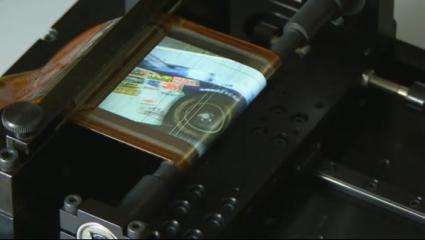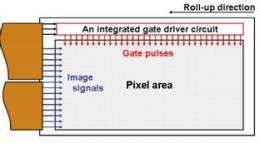Sony develops roll-up OLED video screen (w/ Video)

Japanese electronics giant Sony said Wednesday it had developed what it called "the world's first" prototype flexible colour video screen that is small enough to be rolled around a pencil.
The screen consists of an ultra-thin flexible material covered in organic semiconductors, potentially pointing to a future of flexible mobile devices, television, electronic newspapers and magazines.
"Even after 1,000 cycles of repeatedly rolling-up and stretching the display, there was no clear degradation in the display's ability to reproduce moving images", Sony said of its flexible Organic Light Emitting Display (OLED).
Sony is not the only Japanese firm developing long-lasting flexible displays, with public broadcaster NHK having also worked on similar techniques in recent years.
Japan's department of New Energy and Industrial Technologies (Nedo) is also leading a research programme in a bid to create a manufacturing chain for the displays similar to the way newspapers are printed.
The prototype screen will be presented Thursday at a conference on the sidelines of the Society for Information Display (SID) exhibition in the US city of Seattle, Sony said.
Technology Features (from Sony's press release)
1. High performance OTFT with originally developed high-mobility and highly-stable organic semiconductor materials, PXX derivatives
Sony has developed organic semiconductor material, peri-Xanthenoxanthene (PXX) derivative, which is stable under exposure to oxygen, moisture, light and heat and improved current modulation of eight-times that of conventional OTFT with organic semiconductor of pentacene. Improvement of this OTFT achieved the world's highest-resolution OTFT-driven OLED display with resolution of 121 ppi and 432 x 240 x RGB (FWQVGA) pixels.

2. Integration of a flexible gate-driver circuit with OTFTs
This is the world's first demonstration of an OLED display with an integrated gate-driver circuit with OTFTs. The improvement of the OTFT described above enables integration of a flexible gate-driver circuit with OTFTs on a display panel. The roll-up capability is possible because the rigid driver IC chips has been removed from the display.

3. Enhancement of flexibility with all organic insulators in the OTFT and OLED integration circuit
In order to enhance flexibility of the display, Sony has developed organic insulators for all the insulators in the OTFT and OLED integration circuit. These organic insulators can be formed with the solution process in the atmosphere which is requires fewer steps, and consumes materials and energy more efficiently - thus has a smaller environmental footprint - compared to the conventional high temperature vacuum semiconductor process which use inorganic/silicon materials.
4. Achieved display capable of reproducing moving images while rolled-up around cylinder with 4mm radius
The OTFT-driven OLED display with the aforementioned technologies (1-3) can reproduce moving images while rolled-up around a cylinder with a radius of 4 mm. Even after 1000 cycles of repeatedly rolling-up and stretching the display, there was no clear degradation in the display's ability to reproduce moving images.
(c) 2010 AFP



















